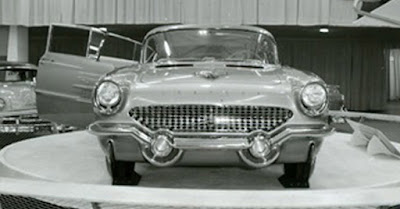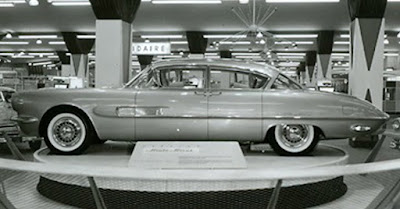Forgotten Icon - Car manufacturers have a long-standing tradition of showcasing concept vehicles or show cars before officially launching their new models. This strategy helps them assess public interest and gather valuable feedback, although historically, many of these show cars were discarded after serving their purpose.
 |
| The Pontiac Strato Streak is designed as a hybrid between a sports car and a sedan by the talented duo of Harley Earl and Art Ross from General Motors and Pontiac Division. (Picture from: Automotive-Heritage) |
One standout example of an innovative concept car is the Pontiac Strato Streak. Designed as a hybrid between a sports car and a sedan, it premiered at the 1954 Motorama auto shows in Chicago alongside the Bonneville Special. Crafted by the talented duo of Harley Earl and Art Ross from General Motors and Pontiac Division, this unique vehicle drew inspiration from Pontiac's Catalina and was constructed on the Star Chief model chassis, featuring a wheelbase of 124 inches and a height of just 54.7 inches.
 |
| The unique Pontiac Strato Streak premiered at the 1954 Motorama auto shows in Chicago, it drew inspiration from Pontiac's Catalina and was constructed on the Star Chief model chassis. (Picture from: Story-Cars) |
The exterior of the Strato Streak was visually striking, boasting a fiberglass body adorned with futuristic elements such as panoramic windows, decorative turbines, and jet exhausts. In contrast to the popular fins of the era, the Strato Streak sported solid pontoon sides and a sleek sloping tail, giving it a distinctive and aerodynamic look. The doors, opening in unconventional directions and interlocking, echoed the design seen in certain European Lancia models.
 |
| The unique Pontiac Strato Streak concept featuring a wheelbase of 124 inches and a height of just 54.7 inches. (Picture from: Story-Cars) |
 |
| The Pontiac Strato Streak offered a luxurious interior with four swivel bucket seats, eliminating the need for a center pillar and facilitating easy entry and exit. (Picture from: Story-Cars) |
 |
| In contrast to the popular fins of the era, the Pontiac Strato Streak sported solid pontoon sides and a sleek sloping tail, giving it a distinctive and aerodynamic look. (Picture from: Story-Cars) |
There's speculation it may have
evolved into the Pontiac Strato Star Concept, showcased at the 1955
Motorama in New York as a sleek two-door sports car. This evolution coincided with Pontiac's introduction of their new small-block overhead-valve V-8 engines from 1955 to 1957, further solidifying its place in automotive history.
 |
| There's speculation the Pontiac Strato Streak may have evolved into the Pontiac Strato Star Concept, a sleek two-door sports car showcased at the 1955 Motorama in New York. (Picture from: LostShow&ConceptCarsOfGM) |
Despite its groundbreaking design and role in showcasing Pontiac's engineering prowess, the ultimate fate of the Strato Streak or Strato Streak II remains a mystery. Like many show cars of its time, it is presumed that the car was eventually scrapped in accordance with the company's policies regarding concept vehicles.
 The legacy of the Pontiac Strato Streak endures as a testament to the innovative spirit of automotive design during that era. Its blend of style, performance, and forward-thinking features continues to captivate car enthusiasts and industry professionals alike, underscoring the lasting impact of concept cars in shaping the trajectory of automobile technology. *** [EKA | FROM VARIOUS SOURCES | STORY-CARS | GOMOTORS | WIKIPEDIA | AUTOMOTIVE-HERITAGE | ALLCARINDEX | REDDIT CONCEPTCARS | LOST SHOW & CONCEPT CARS OF GM | WIKICARS | OLDCONCEPTCARS | AMERICANTORQUE | PINTEREST ]
The legacy of the Pontiac Strato Streak endures as a testament to the innovative spirit of automotive design during that era. Its blend of style, performance, and forward-thinking features continues to captivate car enthusiasts and industry professionals alike, underscoring the lasting impact of concept cars in shaping the trajectory of automobile technology. *** [EKA | FROM VARIOUS SOURCES | STORY-CARS | GOMOTORS | WIKIPEDIA | AUTOMOTIVE-HERITAGE | ALLCARINDEX | REDDIT CONCEPTCARS | LOST SHOW & CONCEPT CARS OF GM | WIKICARS | OLDCONCEPTCARS | AMERICANTORQUE | PINTEREST ]Note: This blog can be accessed via your smart phone.
































